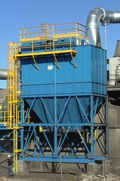 A search for dust collection solutions will turn up a number of possible technologies. One of the more common questions we receive is about electrostatic precipitators (ESPs). In this blog post, we will define what an ESP is, and explain the primary reasons most companies have moved away from this dust collection technology.
A search for dust collection solutions will turn up a number of possible technologies. One of the more common questions we receive is about electrostatic precipitators (ESPs). In this blog post, we will define what an ESP is, and explain the primary reasons most companies have moved away from this dust collection technology.
What Are Electrostatic Precipitators?
As the name implies, this particulate collection process operates via electrostatic forces. A dust-laden air stream passes through a precipitator box which is charged with an electrical field, usually using plates or wires. As the dust passes the charged plates or wires, a corona effect gives the dust particles a positive charge. This causes the dust to “stick” when the positively charged particles are attracted to a set of negatively charged plates. A mechanical portion of the equipment involves striking these plates periodically, causing the dust to fall into a hopper.
This is in contrast to a baghouse dust collector in which air is passed through a filter medium (bag or cartridge) and the particles are captured on the filter exterior while the clean gas passes through. Accumulated dust on the exterior of the filters is typically removed via a compressed air pulse.
Why Electrostatic Precipitators Are Being Replaced by Baghouse Dust Collectors
Most companies have transitioned to the baghouse dust collection solution. There are three main reasons for this transition.
1. ESPs Operate Best with Very Large Airflow
ESPs are only cost effective in applications with very large air flow, due to their high capital cost. Historically, the biggest users of ESPs were coal-fired power plants and paper mills which had high volumes of gas passing through boilers and processing large volumes of air. In the past, baghouse solutions weren’t large enough to support these applications.
However, baghouse technology has advanced over the years and now offers longer bags and better cleaning systems. Baghouses are far more efficient at particulate collection: a typical baghouse efficiency is 99.9% efficiency while ESPs are 98%-99% efficient. Collection efficiency as mandated by the EPA Clean Air Act was a driving force requiring many owners to transition from ESPs to baghouses.
2. Baghouses Provide Cost Savings
ESPs consume significant amounts of electricity, leading to high operating costs. Also, the mechanical components of ESPs are more prone to wear or failure which can result in higher maintenance costs. By contrast, baghouses have no moving parts and the operating costs are mostly limited to the consumption of compressed air and fan or blower horsepower.
Companies still operating ESP dust collectors may be hesitant to switch to a baghouse dust solution. In most cases, changing the dust collection technology requires plants to re-apply for permits because it’s a different dust collection process.
3. Most Particulates Are Slow to Take on an Electric Charge
ESPs work best when the particulate has a propensity for gaining a positive charge. But, many particles don’t or are slow to take on the electric charge which reduces the ESP’s effectiveness.
At Sly, throughout our 143-year history, we’ve stayed on top of the latest dust collection technologies. Baghouse dust collectors have the advantage over electrostatic precipitators. To help you become more familiar with baghouse solutions, we’ve created a Baghouse 101 video training series to teach you everything you need to know. Access the videos or contact us if you have questions.
Tags: dust collection system, baghouse




